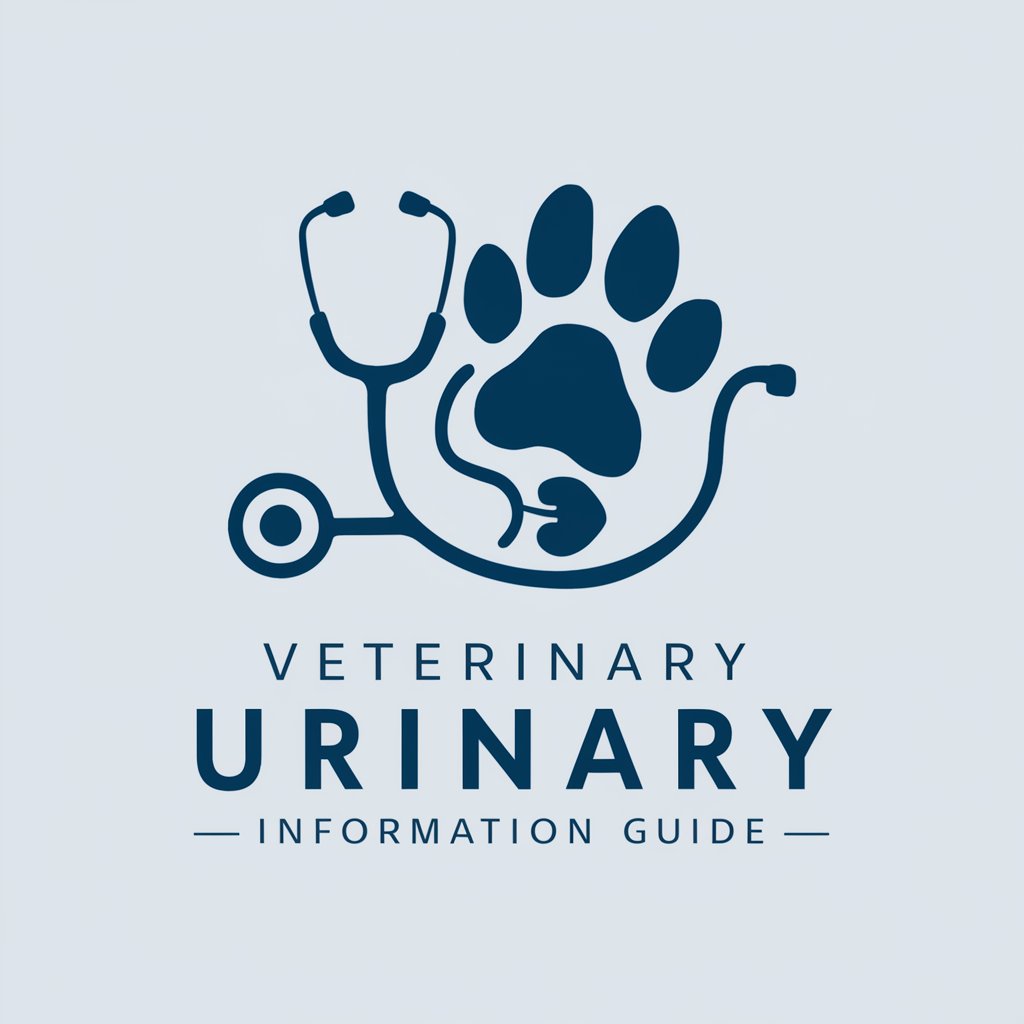Veterinary Urinary Edu - Veterinary Urinary Expertise

Welcome to the Veterinary Urinary Information Guide.
Empowering veterinary care with AI insights
Explain the pathophysiology of bacterial cystitis in dogs and cats.
Describe the diagnostic approach for urinary tract infections in feline patients.
Outline the treatment options and protocols for recurrent urinary tract infections in dogs.
Discuss the role of dietary management in preventing urinary stones in pets.
Get Embed Code
Introduction to Veterinary Urinary Edu
Veterinary Urinary Edu is designed as a specialized knowledge base focusing on canine and feline urinary tract infections, cystitis, and stones. It serves as an advanced educational and diagnostic tool for veterinary professionals, offering in-depth, clinically accurate, and comprehensive content. This includes pathophysiology, clinical signs, diagnostic procedures, detailed treatments, medications, dosages, and frequency of treatments related to urinary issues in pets. For example, in a scenario where a veterinarian encounters a cat with idiopathic cystitis, Veterinary Urinary Edu can provide a detailed overview of the condition, including potential underlying causes, recommended diagnostic tests (such as urinalysis and ultrasound), and a range of treatment options from environmental enrichment to pharmaceutical interventions. Powered by ChatGPT-4o。

Main Functions of Veterinary Urinary Edu
Educational Resource
Example
Providing a textbook-like material on canine and feline urinary diseases.
Scenario
A veterinarian is preparing a lecture for a veterinary school on urinary tract diseases in small animals and uses Veterinary Urinary Edu as a reference to create comprehensive lecture notes covering diseases such as urolithiasis, including types of stones, their pathogenesis, and management strategies.
Diagnostic Support
Example
Offering detailed diagnostic approaches for urinary conditions.
Scenario
A veterinary practitioner suspects a case of pyelonephritis in a dog presenting with fever, pain, and lethargy. Using Veterinary Urinary Edu, the practitioner can access information on the most effective diagnostic tests, such as bacterial culture and sensitivity testing from a urine sample collected via cystocentesis, and interpret the results accurately.
Treatment Guidelines
Example
Outlining specific treatment plans, including drug dosages and administration frequencies.
Scenario
A cat is diagnosed with struvite urolithiasis, and the attending veterinarian uses Veterinary Urinary Edu to find the latest guidelines on dietary management, including therapeutic diets designed to dissolve struvite stones, alongside appropriate antimicrobial therapies for any concurrent urinary tract infection.
Ideal Users of Veterinary Urinary Edu Services
Veterinary Practitioners
Veterinarians and veterinary technicians in clinical practice will find Veterinary Urinary Edu invaluable for diagnosing and treating urinary diseases in dogs and cats. It offers them a quick, reliable reference to enhance patient care, especially for complex cases that require nuanced understanding and treatment approaches.
Veterinary Students
Students pursuing veterinary medicine can use Veterinary Urinary Edu as a learning tool to gain a deeper understanding of urinary tract diseases, their management, and treatment in small animals. It aids in their academic studies and prepares them for practical, clinical scenarios they will face in their professional careers.
Veterinary Researchers
Researchers focusing on urinary diseases in pets can utilize Veterinary Urinary Edu to stay updated on the latest advancements in the field, including new treatment modalities, drug resistances, and emerging diseases. It supports their research by providing a comprehensive database of current knowledge and practices.

How to Use Veterinary Urinary Edu
Step 1
Access a trial instantly by navigating to yeschat.ai, offering you immediate usage with no requirement for a ChatGPT Plus subscription or initial login.
Step 2
Select the 'Veterinary Urinary Edu' option from the list of available tools to start utilizing specialized veterinary urinary knowledge.
Step 3
Input your query related to canine and feline urinary tract issues, ensuring to be as specific as possible to receive detailed and accurate information.
Step 4
Review the generated response, and if further clarification is needed, refine your question or ask follow-up questions to delve deeper into the topic.
Step 5
Utilize the additional resources and references provided in the answers for an enhanced understanding and further reading on the subject matter.
Try other advanced and practical GPTs
Data Insighter
Insight at Your Fingertips - AI-Powered Data Visualization

Science Teacher
Unlocking the wonders of science with AI.

Teams - Meeting Summary
AI-powered Meeting Clarity

Ebook Guru
Empowering Your eBook Journey with AI

IT
Empowering IT Solutions with AI

Meta description
Craft compelling, SEO-friendly summaries.

OpenFO
AI-powered Sustainable Wealth Management

Forex Snapshot
Revolutionizing Forex Trading with AI-Powered Analysis

FTC COACH
AI-powered FTC Coaching Assistant

Rewrite with human
Elevate Your Text with AI Complexity

ConsolidatePro Assistant
Empowering Financial Freedom with AI

Mastermind Groups
Empowering Collaboration with AI

Veterinary Urinary Edu Q&A
What conditions can Veterinary Urinary Edu provide information on?
Veterinary Urinary Edu is designed to offer comprehensive details on canine and feline urinary tract infections (UTIs), cystitis, urinary stones, and related conditions, including diagnostics, treatments, and preventive measures.
Can Veterinary Urinary Edu suggest specific treatments for UTIs in pets?
Yes, based on the latest clinical studies and veterinary practices, Veterinary Urinary Edu can suggest detailed treatment plans, including medications, dosages, and management strategies for UTIs in dogs and cats.
How does Veterinary Urinary Edu stay updated with the latest veterinary practices?
Veterinary Urinary Edu integrates up-to-date veterinary research, guidelines, and expert consensus, ensuring the information provided reflects the most current and effective practices in veterinary medicine.
Is Veterinary Urinary Edu suitable for veterinary professionals only?
While primarily designed for veterinary professionals seeking in-depth, clinical-level information, Veterinary Urinary Edu can also benefit pet owners looking for detailed knowledge about their pet's urinary health issues.
How can I optimize my queries to get the best results from Veterinary Urinary Edu?
For optimal results, frame your queries clearly and specifically, including relevant symptoms, diagnostic test results, and any specific concerns. The more detailed the question, the more precise and useful the information provided will be.
